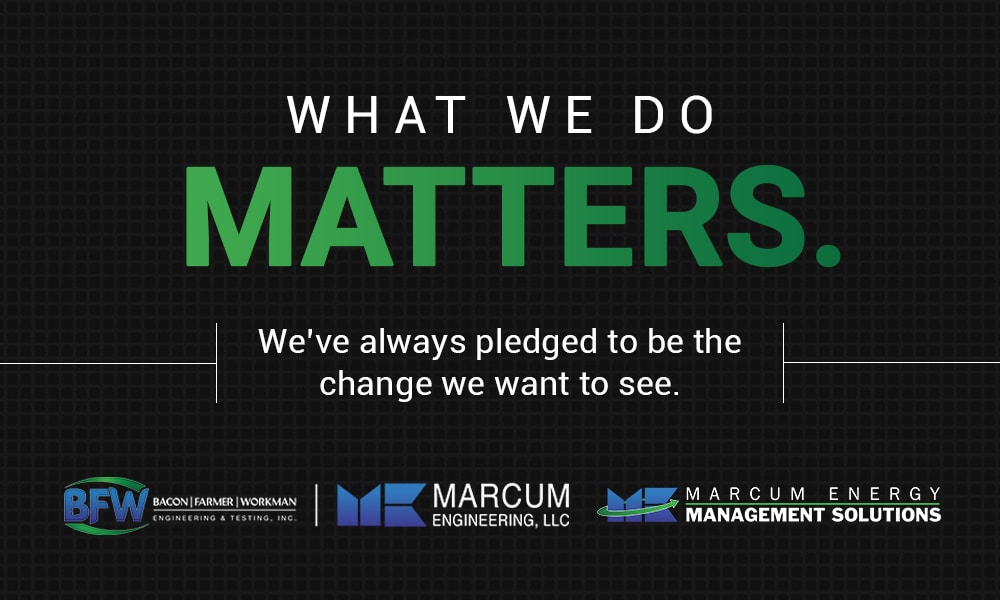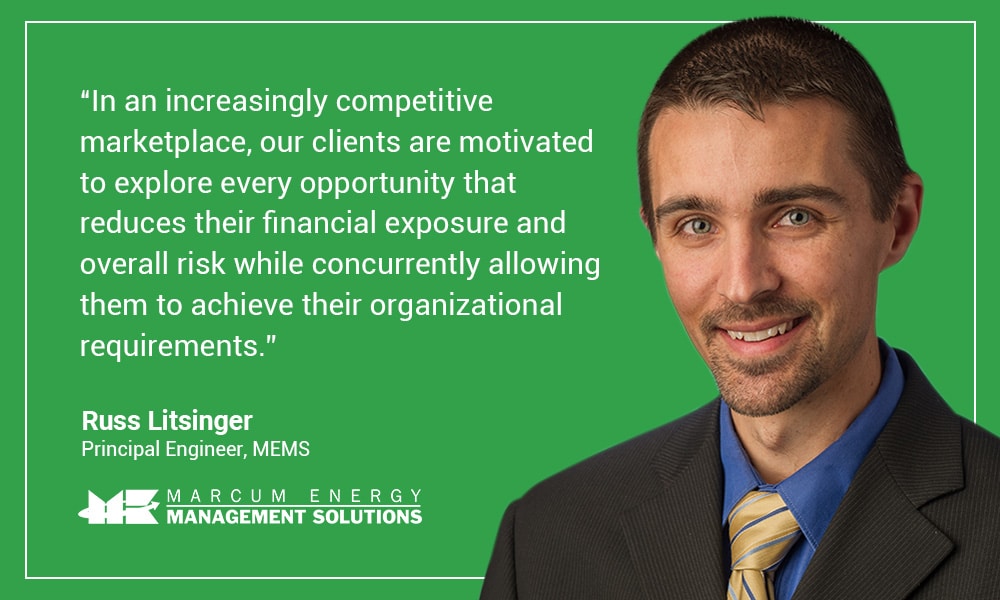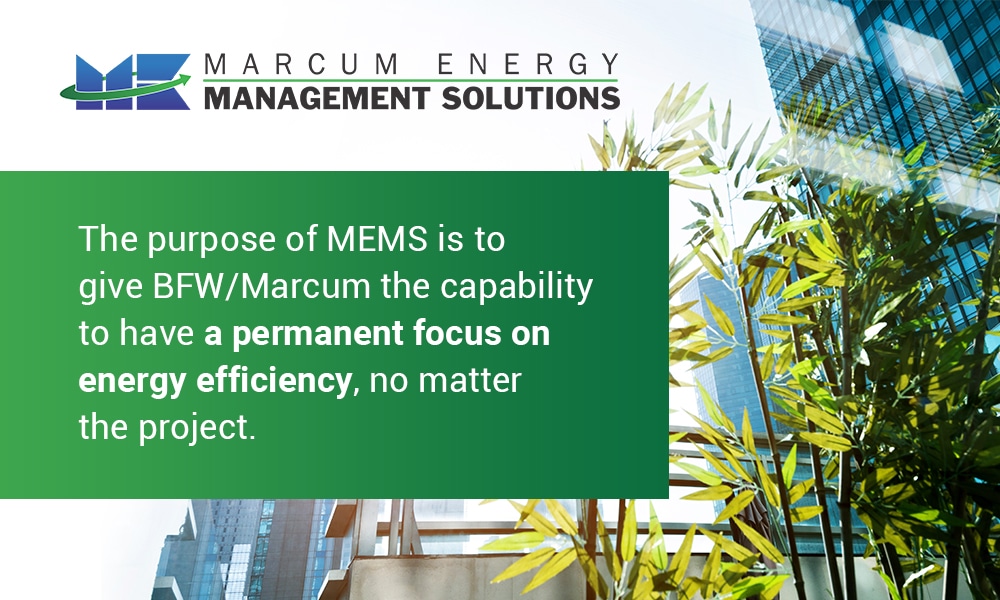Engineering isn’t only about design and construction. What you build and how you build it has a significant impact on the community at large, too. As a community figure, it’s BFW/Marcum’s responsibility to lead by example. We’re well aware of the relationship we have with our community, be it our neighborhood, our country, or even the global ecosystem.
What we do matters. We’ve always pledged to be the change we want to see. Part of that is in our investment into high-performance engineering.
What Is a High-Performance Building?
The Associated Builders and Contractors (ABC) organization explains it well:
A building that integrates and optimizes on a life cycle basis all major high-performance attributes, including energy conservation, environment, safety, security, durability, accessibility, cost‐benefit, productivity, sustainability, functionality, and operational considerations.
To put it simply, high-performance engineering is a holistic approach to the planning, design, and construction of buildings to achieve high-efficiency standards across all aspects of their functionality.
In our industry, it’s more important than ever to minimize the impact a project has on the environment. Our efforts should minimally impact the existing ecosystem for the entirety of a building’s lifetime. At BFW/Marcum, our goal is to enhance a given community with minimal impact.
Why is High-Performance Engineering Important?
Sustainability has become increasingly important. We must strive to do more with less and plan our future structures so that they have as little impact on the environment as possible. Baccus Oliver, Principal of Marcum Engineering, and Russ Litsinger, Principal Engineer of Marcum Energy Management Solutions (MEMS), share their perspectives on the concept of high-performance building.
Baccus goes into detail on the importance of sustainability in our lifetimes:
“The sustainability of our planet is at stake. In response, we are pushing our building systems’ performances to be ultra-efficient to reduce our reliance on natural resources. A high-efficiency building will reduce its carbon footprint on our world and save our clients much-needed funds over the entire life of the building.”
Russ explains why our approach to high-efficiency engineering practices is incredibly important to our clients:
“In an increasingly competitive marketplace, our clients are motivated to explore every opportunity that reduces their financial exposure and overall risk while concurrently allowing them to achieve their organizational requirements. If the requirements of their built environment can be satisfied while also simultaneously reducing their operating budget, a synergism occurs which best positions them for a sustainable competitive advantage in their respective industry.”
In short, we’re at a time in our planet’s lifecycle where it’s essential to reduce the impact of our actions. We’re providing our clients with cutting-edge innovation that also reduces the long-term costs associated with their building. While it’s a more prolonged strategy compared to the money saved through cutting corners, high-performance engineering is a cost-saving measure that will sustain itself throughout the entire life of our client’s building. It’s a win-win situation for anyone willing to invest in the future.
What Does the Future Look Like?
The future is always exciting for those of us who revel in technological innovation. For a company in the engineering industry, it’s also important to completely understand where things are headed to ensure you’re ahead of the curve. To establish yourself as an industry leader, you often have to make the first move. At BFW/Marcum, we’re constantly forecasting the future of engineering.
Baccus imagines that the near future will be an exciting time:
“We definitely will see a time in which buildings will be net-zero; meaning they will produce more energy than they consume with renewable technologies such as solar and wind harvesting.”
It may sound like science fiction to engineer a building full of commercial and residential tenants that produces more energy than it consumes, but we’re making great strides in that direction.
The American Society of Heating, Refrigerating, and Air-Conditioning Engineers (ASHRAE) first published a code of standards in 2009 meant to measure a building’s energy use based off of metered energy information (think of your gas and electric meter at home). This is a useful tool, but their goal was to achieve the ability to estimate energy-usage before a building is even constructed. They aim to standardize energy use so that it can be accurately simulated, measured, and compared purely by a building’s planned characteristics. In 2019, they’ve made great strides in that direction.
According to Russ, the organization’s standard has improved immensely since its creation:
“The newest ASHRAE standard is designed to ultimately replace the current prescriptive-based ASHRAE 90.1, the ‘Energy Standard for Buildings’ and is constructed to complement ASHRAE’s Building Energy Quotient (bEQ) platform, which is intended to provide a code-enforceable energy-usage footprint for commercial and institutional facilities based on functional use and climate.”
How is BFW/Marcum Supporting the Future of Engineering?
We’re not just interested in being at the forefront of the trend toward high-performance engineering; we want to be the innovators that carve out the path. Supporting the future of engineering means investing in long-term solutions. We support our team members’ pursuits of LEED accreditation whenever possible. Our constant encouragement of this pursuit has led us to cultivate a diverse team of engineers accredited in high-efficiency engineering.
Most of all, we founded Marcum Energy Management Solutions (MEMS), which Russ leads. The purpose of MEMS is to give BFW/Marcum the capability to have a permanent focus on energy efficiency, no matter the project. We can advise our clients on energy standards at all times. Russ is an expert in his field and understands the delicate balance between client-needs and environmental standards.
“All of our design decisions are based on the foundational concept of making the business case for energy efficiency. We seek to evaluate every market-ready option on the primary basis of its impact on the Lifecycle Net Present Value of the investment while also considering the client’s needs and preferences regarding maintainability, standardization and any other relevant functional requirement.”
We’ve Made the Investment to Assist Our Clients and the Environment
Our investment into the future of sustainability helps our clients stay ahead of the curve, and it acts as an environmentally conscious approach to our continued growth as a company. We’re committed to increasing our knowledge and the quality of our resources because we know that when we do things right, no one loses.
Russ is well ahead of the high-efficiency paradigm and fully committed to the effort to continue to scale our high-performance engineering investments.
“We keep apprised of emerging technologies and trends by active participation in the leading energy industry societies (AEE, ASHRAE, USGBC). We invest in personal growth and development by pursuing industry-standard certifications in the energy realm (CEM, GBE, CxA, BEMP, HBDP, LEED AP BD+C). And we invest in tools and technologies (IESVE: https://www.iesve.com/) which give us the tools to assist our clients in making actionable decisions which are optimized to their specific application.”
To Stay Ahead, You Need to Keep Your Eyes on the Horizon
To innovate, you can never be satisfied. To be at the forefront of this industry, you can never rest on your laurels. Russ and his leadership at MEMS is our guide into the future of engineering, and with his consultation , we fully expect our clients will meet us there.
“We aspire to remain at the forefront of the emerging field of performance-driven energy engineering. We seek to build and expand upon both the range and depth of solutions that we provide to our existing clients and to pursue additional opportunities with prospective clients who value the ability to make investments into their built environment which are supported by robust financial evaluations.”





Recent Comments